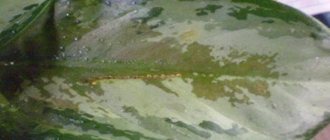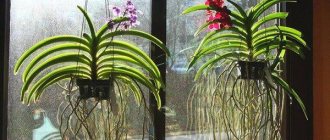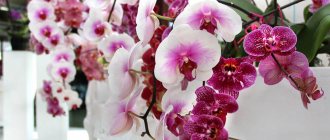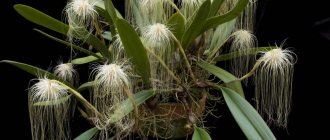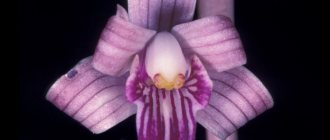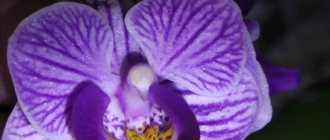Detailed description and photo
The Manhattan orchid belongs to the genus Phalaenopsis (lat. Phalaenopsis Manhatten) . She has become a favorite of many connoisseurs of indoor floriculture. It usually comes in soft pink and lilac colors with numerous speckles of a dark lilac hue, giving the flower a “marbled” appearance.
Specks tend to disappear when the flower is insufficiently illuminated and reappear with additional lighting.
The lip of the flower is bright yellow with orange hues and splashes of a darker color than the petals. The flower has a classic shape, has 3 sepals, called sepals, and 3 petals (petals), with a diameter of 8-10 cm.
Peduncles are straight, slightly inclined, 55–60 cm high, bearing up to 10–14 flowers. The flower arrow usually branches, thereby increasing the duration of the orchid's flowering.
The leaves are smooth, leathery, obovate , up to 20 cm long. In good lighting, just like on the flower, specks of a darker shade are noticeable. Typically, an adult plant has 3 to 6 leaves.
A characteristic feature of the orchid root system is the presence of aerial roots covered with a layer of velamen. With proper care, the Manhattan orchid usually has such roots that are well developed and cope with the task of providing the plant with a sufficient amount of moisture.
How is it different from other types?
First of all, the genus Phalaenopsis, to which the Manhattan orchid belongs, is distinguished from other types of orchids by the following characteristics:
- Short stem and wide leathery leaves.
- Aerial roots covered with a layer of velamen.
- Peduncles, as well as aerial roots, grow in special axils between the leaves.
- They grow only upward, usually branching.
- The flowers resemble butterflies, hence the name of the genus.
The difference between the Manhattan variety and other phalaenopsis varieties is:
- The presence of specks of a darker color on the surface of the entire flower, which can disappear with a lack of light.
- The flowers are light pink and light lilac.
- Bright yellow with hints of orange and speckles.
- Lack of aroma.
History of the species, origin and place of residence
first discovered by Pastor Perer Osbeck on the Swedish island of Ternate in 1752. Soon, some units were sent to the botanist Carl Linnaeus, who distributed the Manhattan variety throughout the world. The flower got its name from trade. Depending on the manufacturer, it may vary, because this hybrid is not officially registered anywhere. In most cases, the name Phalaenopsis Manhattan is found.
Homeland of the Manhattan orchid: countries of the Malay Archipelago. In its natural habitat, the flower can be found in the mountain forests of the Philippines and the wet plains of Australia.
Bloom
The flowering period of the Manhattan orchid is quite long and can last all year.
When and how does it bloom?
With sufficient lighting and a comfortable temperature, an orchid can throw out several branching flower arrows. Their sequential flowering can continue throughout the year, but in winter additional lighting will be required. However, more often in winter there is a short period of rest.
On the peduncle there are up to 14 flowers of delicate light pink and light lilac color , covered with small inclusions darker than the main color.
What do the fruits look like?
The fruit of an orchid is a capsule with 3-6 valves, in which up to 1 million tiny dust-like seeds can ripen.
Hybrids
Botany is full of surprises.
One of the pleasant discoveries was the easy crossing of different types of phalaenopsis with each other, in which previously unknown shapes and shades of colors appear.
Industrial cultivation and sale dictates its own rules.
Absolutely identical ideal plants on a store shelf are most likely clones of a successful hybrid.
When crossing different types of phalaenopsis, such beautiful hybrids are obtained.
Biologists are striving to obtain new combinations of specks, unusual petal shapes and contrast with the lip.
Thousands of orchid hybrids can be described in the form of an encyclopedia in several volumes rather than within the confines of a single article.
Groups are distinguished by size and type of flowering.
Miniature
Flowers are not for a bouquet, but to take home, look after and care for, that’s what mini phalaenopsis is.
Here comes Mini Mark.
Before the creation of this group of hybrids, orchids were most often cut for bouquets.
A plant that is small in size and height is easier to maintain. Fragile flowers do not lose their grace and evoke tenderness.
Taiwanese
Bright, large, even provocative tropical flowers, unlike the first hybrids of porcelain-flat flowers.
A play of nature that imitates the work of a calligraphy master, but in reality it is the painstaking work of botanists.
Taiwan Phalaenopsis 'Red Cat'.
Of course, they are unpretentious to indoor growing conditions, because their creators took care of this.
This direction of orchid hybridization is rapidly developing. New color options for orchid petals are appearing.
Very popular are the species in which the corolla of petals and the lip are painted in contrasting shades.
Botanists have managed to achieve previously inaccessible golden-yellow, peach, and orange phalaenopsis flowers, and something new appears every day.
Novelty
A group of hybrids distinguished by flowering type.
Attention! A remarkable distinctive property is that after flowering ends, the flower stalks go into a dormant period, and then new buds grow from the apical bud and flowering continues. This process can be repeated several times. The flower brush is very compact, raised above the rosette of leaves.
The flower raceme is very compact, raised above the rosette of leaves.
Taiwan Novelty Phalaenopsis.
At the same time, the plant produces two or more flower stalks.
This group of hybrids contains all the variety of colors developed over the years of work by biologists.
Blots, strokes, dashes and other food for imagination on dense petals of the correct shape.
Planting material and its cost
Orchid planting material (babies, cuttings) are rarely on sale; they usually sell a ready-made plant . Occasionally can be seen for sale on the Internet.
Planting material at home can be obtained from an adult plant. Under favorable conditions, orchid roots can produce babies. Sometimes such babies (keiki) can grow on a peduncle. Within six months, they grow leaves and roots. When the roots of the baby reach a length of 5-6 cm, it can be transplanted into a separate pot.
Reproduction
Phalaenopsis Orchid
To propagate orchids, the seed method is used, propagation by children and layering, that is, vegetatively. Only experienced collectors can obtain new specimens through cloning.
Seed method
Orchid from seeds
The main condition for seed germination is nutritious soil. And it can only be obtained in a laboratory setting. Here you can achieve sterility.
If someone at home decides to undertake this labor-intensive process - germinating seeds, you need to prepare yourself for the fact that this is a long process and it takes 9 months.
Rastuski grow for 3 years, and only after 4 years can you see the flowering of phalaenopsis. Some flowers do not want to please their owner and do not bloom for 10 years.
Let's look at the process step by step. Seeds should be placed in prepared moist soil consisting of moss and leafy soil and the bowl should be covered with glass. There should be drainage at the bottom. Germination requires high temperature and humidity.
Picking is carried out with tweezers when one leaf develops on the seedlings. Planting in separate pots - after 4 leaves appear on the plant.
How to propagate by cuttings?
Dividing shoots into cuttings
To propagate by cuttings, you need to choose a plant that has only one growth point.
Cuttings should be taken from a healthy mother plant; damaged cuttings can be discarded. Brown spots on the stems of indoor orchids most often indicate that non-infectious or fungal diseases are present, and may be a sign of rot or spotting.
The shoots should only be cut with sharp pruning shears; scissors can damage the internal tissue. The bottom cut must be sprinkled with crushed crushed coal.
When rooting, the bottom of the container should be filled with drainage material. These can be pieces of foam plastic, small fractions of expanded clay, sphagnum moss. You can fill it with pebbles.
All planted cuttings must be covered with polyethylene or a plastic container placed in a greenhouse in which the necessary microclimate will be created. Orchids will grow and develop well.
Plantings should be watered using a spray bottle with warm water, avoiding waterlogging of the soil. Excessive waterlogging will cause rot.
Planting children
The baby appeared on the peduncle
Only some phalaenopsis grown in suitable conditions can produce lateral shoots - babies. They should be separated from the adult specimen carefully, otherwise they will not produce their own roots. To obtain planting material, mother plants must be kept in a room with high temperature.
And also to obtain them it is necessary to apply fertilizers with a high concentration of nitrogen.
After the baby is born, she needs to be protected. And when your root appears, carefully separate it, treat the cut with charcoal and transplant it into a new pot.
Cloning
Orchid
Propagating an orchid by cloning is something only scientists can do. No one can do it at home.
All work on preparing material for propagation is carried out under a microscope in the laboratory. The taken cells are placed in a nutrient mixture. When the nutrient medium turns into clots, it is replaced with a new one. Cell division results in many plants.
A good way to do business selling flowers.
House rose (indoor) in a pot: care after purchase, cultivation (20+ Photos & Videos) + Reviews
What should the soil be like?
The soil for growing an orchid must contain:
- Tree bark. It is best to use pine bark, which must be thoroughly boiled and calcined to kill pests.
- Charcoal.
- Moss, it is best to use sphagnum.
- Drainage layer. To create it, you can use polystyrene foam, expanded clay, perlite, vermiculite, and coconut chips.
Step-by-step instruction
How to plant correctly:
- Prepare the pot and fill it 2/3 full with substrate.
- Using a sharp knife, carefully cut the baby from the mother plant. Half an hour later, after the cut area has dried, sprinkle it with charcoal or lubricate it with brilliant green.
- Place the plant in the pot, holding it by the neck, spreading the roots over the surface of the soil.
- Sprinkle with the remaining soil so that the root system is located above the edge of the pot. The soil should not be compacted.
- Watering should be done after a few days.
Correct planting and transplantation
Soil selection
The soil, or as it is correctly called, the substrate, is the guarantor of the stability, development and nutrition of the orchid. You can purchase it ready-made at almost any flower center.
In the absence of the opportunity, it is not difficult to prepare it yourself , the main thing is to select high-quality and correct proportions of ingredients:
- tree bark (preferably pine), well boiled or calcined, with a fraction of 1.5-2 cm;
- charcoal;
- sphagnum moss;
- inert materials: perlite, vermiculite, expanded clay or foam.
Coconut chips and fibers are also used.
Advice! A small amount of peat is used to reduce the alkalization of the soil from watering with hard water.
Optimal capacity
The root system of phalaenopsis is involved in photosynthesis, so the container must transmit light. Plus, for good aeration and ventilation of the roots, the optimal amount of air must be supplied.
Transparent plastic pots are ideal for growing these types of orchids , in which you can easily make the required number of drainage and ventilated holes.
Also, the root system prefers a little cramped conditions. Due to this property, the pot is selected in size 2-3 cm wider than the size of the root part.
Transparent plastic pots are best suited for planting.
Technology
Timely and adequate transplantation has a beneficial effect on the development of the orchid . Even during the flowering period, a correctly done transplant will not have a noticeable effect.
- Typically, the plant is replanted after flowering, once every 2-3 years, to replace a decomposed, compacted substrate that does not provide the necessary processes.
- Or when there is a large growth of the root system that no longer fits into the container.
- Another important reason for replanting is disease processes in the root part of the plant.
The transplant procedure primarily includes:
- carefully removing the plant from the container;
- soaking and examining the roots;
- treatment of the root part from dry, damaged areas;
- treatment of sections with activated carbon;
- drying.
A drainage made of inert materials is placed at the bottom of a new prepared container . A small layer of bark is placed on it, with a larger fraction of 2-3 cm, which is pre-sprayed with water.
Then the root system is lowered into the container and the inter-root space is carefully filled so as not to damage the roots. It is better to use a wooden stick for this procedure to lightly compact the substrate throughout the entire volume of the pot.
The root collar is not buried. If necessary, in case of dry air in the room, the surface is mulched with sphagnum moss. After planting, the plant is not watered for 3-4 days.
Caring for a plant at home
Caring for the plant is not difficult; it is necessary to maintain optimal conditions for growth and flowering.
- Temperature . The comfort temperature for the Manhattan orchid is 22-25 degrees; in winter, 18-20 is allowed.
- Lighting . The plant should be in a well-lit place, but direct sunlight should be avoided. In winter, to maintain flowering, illumination with a phytolamp is recommended.
- Watering . Watering should be done once a week in summer, and once every 10-14 days in winter. Under no circumstances should the flower be over-watered. It is best to place the pot in a deep tray with settled water at room temperature for 20-30 minutes. You can spray the plant without allowing drops of water to fall on the flower or leaves.
- Feeding . For feeding, you should use special fertilizers for orchids, which can be found in flower shops. Fertilize after watering, on moist soil, so as not to burn the roots with chemicals.
- Trimming . It is recommended to trim the peduncle after flowering only if it dries out. If the arrow does not dry out after flowering, it may bloom again. If it does not occur for a long time, the arrow is cut 1.5 cm above the dormant bud.
- Transplant . It is not advisable to replant an orchid often. It is better to do this if the root system has grown too much and requires replanting into a larger pot. You also need to replant the plant if the soil becomes unusable.
- Care during the flowering period . During the flowering period, no additional care is required. Maintaining optimal temperature, sufficient lighting, timely moistening and fertilizing will allow the orchid to bloom for a long time.
Transplant procedure
There are two main reasons why plants are replanted from time to time:
- the root system has grown excessively and no longer fits in the pot;
- the substrate became over-compacted, decomposed and became unusable.
In any case, the procedure is carried out every 2-3 years, upon completion of the flowering phase. The plant is carefully removed from the container and, after soaking the roots, it is visually inspected for the presence of damaged, injured and dried particles. Such areas are cut off, and the cut areas are disinfected with activated carbon. After this, the roots are dried.
The bottom of the new container is covered with a 2-centimeter layer of drainage, and moistened tree bark is laid on top of it in a layer 3 cm high. Only after this the Manhattan root system is placed in the pot and the plant is carefully covered with substrate. To facilitate the procedure, use a small wooden stick, which is used to compact the substrate along the entire diameter of the pot. If the room is dry, then the surface of the substrate is mulched with sphagnum. The first irrigation is carried out only after 3-4 days after transplantation.
The root collar is left free, not covered with soil.
Diseases and pests
Orchid diseases, like human diseases, are divided into viral, fungal and bacterial. To treat flower diseases, it is most often necessary to cut out the diseased area with a sharp sterile instrument, capturing healthy tissue.
The cut area must be treated with brilliant green or iodine and sprinkled with crushed coal. To treat specific diseases, special commercially available drugs are used.
Flowers can also be damaged by pests, which most often infect orchids from neighboring plants, unsterile soil, or by purchasing a flower infested with pests in a store.
Major pests:
- thrips;
- nematodes;
- mealybug;
- spider mite;
- aphid;
- scale insects;
- woodlice;
- idiots.
For effective pest control, the following drugs are used: Aktara, Actellik, Fitoverm, Agravertin. Use according to the instructions on the package.
Prevention of various problems
Preventing problems when growing Manhattan orchids includes the following measures::
- Careful inspection and treatment of the plant after purchase.
- Periodic preventive treatment with the biological product "Fitoverm".
- Fulfilling the requirements for keeping an orchid: temperature conditions, timely watering, ventilation without drafts.
As we can see, caring for a Manhattan orchid is actually not a very labor-intensive task and following simple rules for maintaining a flower does not take much time. But elegant, delicate flowers can delight you for a long time.
